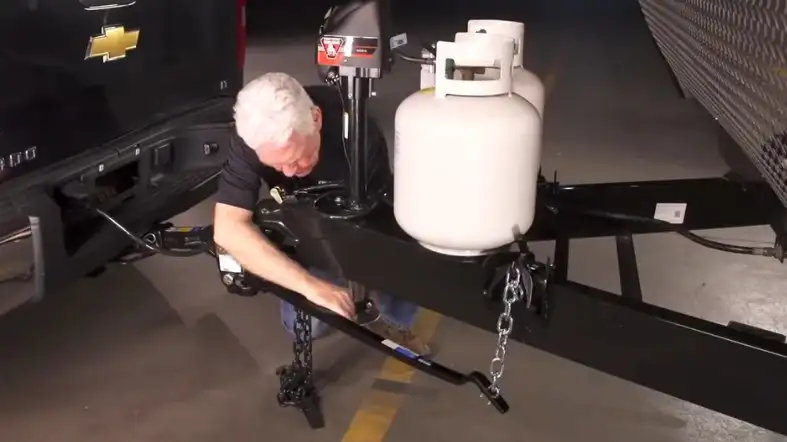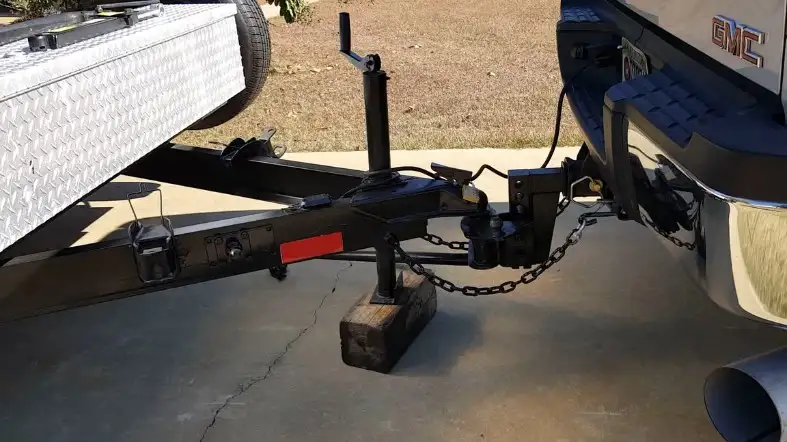When you’re towing a trailer, it’s important that the weight is evenly distributed between the tow vehicle and the trailer.
That’s where a weight-distributing hitch comes in.
A weight-distributing hitch helps to ensure that both the tow vehicle and the trailer are carrying an equal share of the load.
How does it do this?
Let’s take a closer look!
How Does A Weight-Distributing Hitch Work?
A weight distribution hitch uses spring bars to distribute the tongue weight evenly between the trailer and tow vehicle axles.
This allows both to be more parallel with the road, improving stability and handling.

The WD hitch couples to the trailer using a trailer ball and has one end attached to the trailer frame and the other near the receiver on the vehicle.
What are the parts?
Weight distribution hitches have three main parts:
The trailer ball
The trailer ball is what couples the hitch to the trailer.
This is similar to a ball mount.
This is attached to the trailer frame and the other is near the receiver on the vehicle.
The spring bars
The spring bars are what distribute the weight evenly between the vehicle and trailer axles.
This is attached to the trailer frame on one end and to the receiver on the vehicle.
The hitch head
And finally, the hitch head is what attaches the spring bars to the vehicle.
This is what goes into the receiver on the vehicle.
Why Does A Weight-Distributing Hitch Work?

A weight distribution hitch is useful for a couple of reasons.
Distribute the tongue weight
First, it helps to distribute the tongue weight evenly between the trailer and tow vehicle axles.
This can help to keep both the trailer and vehicle more parallel with the road, which can improve handling and safety.
Reduce wear and tear
A WD hitch can help to reduce wear and tear on both the trailer and tow vehicle.
Distributing the tongue weight more evenly helps to take some of the stress off of the hitch itself, as well as the axles and suspension components of both the trailer and vehicle.
Prevent sag
Weight distribution hitches are particularly useful for heavier trailers, as they help to prevent sag at the rear of the vehicle.
They can also be helpful when towing in hilly or mountainous terrain, as they help to keep the trailer level.
If you are planning on doing any serious towing, a weight distribution hitch is an essential piece of equipment.
It can help to make your journey safer and more enjoyable.
How To Install A Weight-Distributing Hitch?
Installing a weight distribution hitch is not difficult, but there are a few things you need to know before you get started.
Determine the tongue weight
The first thing you need to do is determine the tongue weight of your trailer.
This can be done by putting the trailer on a scale or by using a tongue weight scale.
Once you know the tongue weight, you can select the appropriate size spring bars for your hitch.
Attach the spring bar
Next, you need to attach the spring bars to the hitch.
The hitch should have two holes for the spring bars, one on each side.
Once the spring bars are attached, you can then attach the hitch to the trailer ball.
Adjust the tension
Finally, you will need to adjust the tension on the spring bars so that the tongue weight is evenly distributed between the trailer and the tow vehicle.
This can be done by adjusting the chains that are attached to the spring bars.
Once the tension is adjusted, you should be able to tow your trailer without any problems.
How To Maintain A Weight-Distributing Hitch?

It is important to regularly maintain your weight distribution hitch to ensure safe and optimal performance.
Here are some tips on how to do so:
Inspect the spring bars and chains for any damage or wear
The spring bar chains are an important part of the weight distribution hitch, and they should be inspected regularly for any damage or wear.
If they are damaged, they should be replaced as soon as possible to ensure safe and optimal performance.
Lubricate all moving parts with WD-40 or a similar lubricant
It is important to regularly lubricate all moving parts of your weight distribution hitch with WD-40 or a similar lubricant.
This will help ensure smooth operation and prevent damage or wear.
Check the bolts and brackets
It is also important to check the bolts and brackets for any damage or looseness.
These should be tightened or replaced as needed to ensure that the hitch is in good working condition.
This is important for ensuring that the hitch is properly secured and functioning correctly.
Check the hitch balls and couplers
Last, but not least, be sure to check the hitch balls and couplers for any damage or wear.
These should also be replaced as needed to maintain optimal performance and safety.
Inspect the receiver hitch
It is also important to regularly inspect the receiver hitch for any damage or wear.
This should be replaced as needed to maintain optimal performance and safety.
Tips For Using A Weight-Distributing Hitch

Below are some tips to follow
- Before hitching up, make sure the trailer is level. If it’s not, adjust the tongue weight until it is.
- When hooking up the hitch, make sure the spring bars are in the proper position. If they’re not, they won’t distribute the weight evenly and could cause problems down the road.
- Be sure to check the tension of the spring bars before hitting the road. If they’re too loose, the hitch won’t work properly. If they’re too tight, it could damage the trailer or tow vehicle.
- If you’re ever unsure about anything, always err on the side of caution and consult a professional. They’ll be able to help you get hitched up safely and correctly.
FAQ about weight-distributing hitches
How Does A Weight-Distributing Hitch Work?
Weight distribution hitches use spring bars to spread the tongue weight evenly between the trailer and tow vehicle axles, making both more parallel with the road.
What Are The Benefits Of Using A Weight-Distributing Hitch?
There are several benefits to using a weight-distributing hitch, including improved braking and handling, increased stability, and decreased wear and tear on your vehicle and trailer.
If You’re Not Sure Whether Or Not You Need A Weight-Distributing Hitch, What Do You Do?
If you are towing a trailer that is heavy or carries a lot of weight in the front, you may need a weight-distributing hitch.
How Do I Set Up A Weight-Distributing Hitch?
Most weight-distributing hitches are relatively easy to set up.
First, you will need to attach the hitch to your vehicle.
Then, you will need to attach the spring bars to the trailer.
Finally, you will need to adjust the tension on the spring bars to ensure that the tongue weight is evenly distributed.
What Are The Signs That My Weight-Distributing Hitch Is Not Working Properly?
If you notice that your vehicle or trailer is not tracking straight, that your braking performance has decreased, or that your vehicle or trailer is swaying more than usual, it may be a sign of a problem with your weight-distributing hitch.
Will A Weight Distribution Hitch Fit With Any Tow Vehicle Hitch?
Most weight distribution hitches are designed to fit with any standard tow vehicle hitch.
However, it is always best to consult with the manufacturer of your hitch to ensure compatibility.
How Does A Load Leveling Hitch Work?
A load leveling hitch works by distributing the weight of the trailer evenly between the tow vehicle and the trailer’s axle.
This helps to prevent the trailer from fishtailing or swaying, which can be dangerous.
The hitch also helps to keep the tow vehicle from being overloaded, as it takes some of the weight off of the vehicle’s rear axle.
The final thoughts
Now you know the answer to the question, “How does a weight distributing hitch work?”
A weight distributing hitch works by using spring bars to transfer some of the tongue weight from the back of your truck or RV to all axles on your vehicle.
This not only helps distribute the weight more evenly across your vehicle but also makes towing easier and safer.
So next time you’re towing a heavy load, be sure to use a weight distributing hitch and enjoy your trip!
